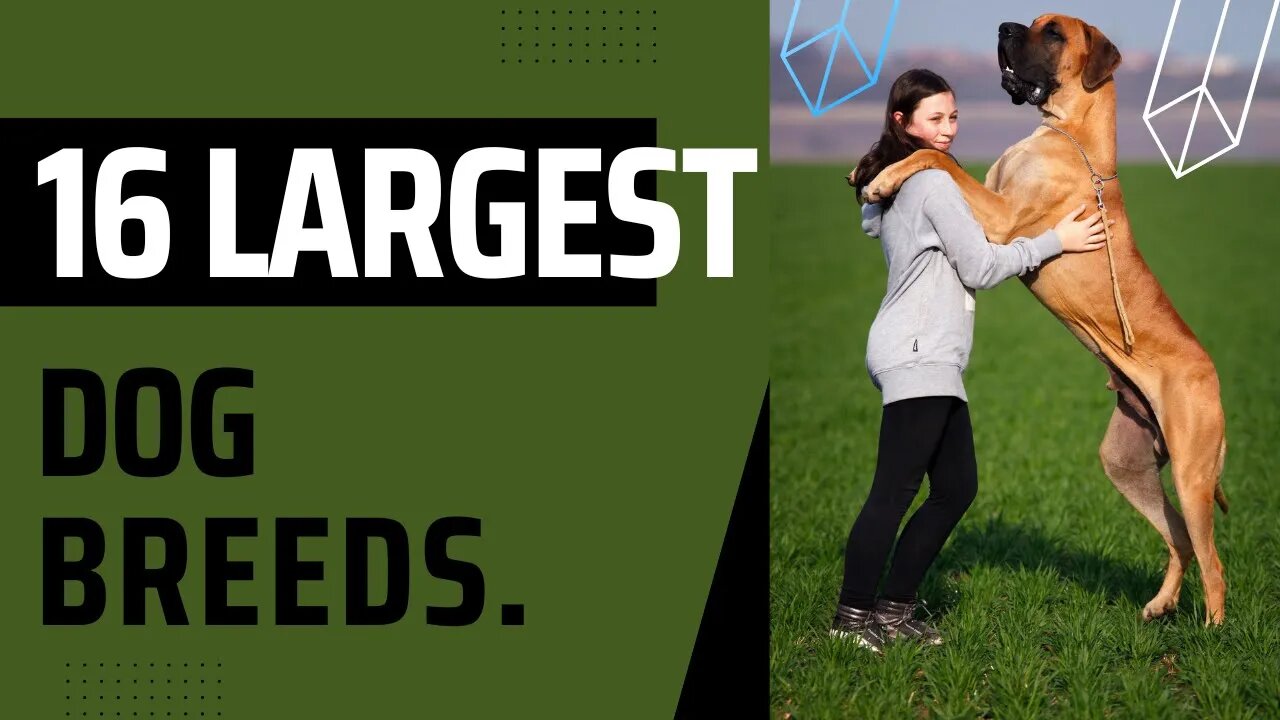Premium Only Content

16 Largest Dog Breeds.
To buy "Facts about Animals" a coffee: https://www.buymeacoffee.com/AnimalsandFacts
To become our contributor: https://www.buymeacoffee.com/AnimalsandFacts/wishlist
Giant dogs are some of the hardest-working and most recognizable breeds. But because many of them maintain the strong working instincts and drive they were bred for, they can be a lot to handle. Here are some things to keep in mind if you’re considering adding one to your family.
Maturation
Giant dogs are giant puppies for a very long time and are slow to mature both mentally and physically. When giant dogs are young, their joints can become injured easily, so it’s important to be very cautious with exercise.
Space
The bigger the dog, the bigger everything needs to be—including toys, bowls, and beds. While some giant dogs are happy and content living in small spaces, you do need to have enough space for the things they need. It’s also important to keep in mind that not everyone or everywhere is going to be giant-dog-friendly. Many apartments and hotels have weight limits for dogs, which giant breeds far exceed. It can also be much more challenging to find skilled and qualified care from dog sitters or walkers.
Cost
Giant dogs can be expensive to care for. When the dog is bigger, the bill usually is as well. Before adding a giant dog breed to your family, consider your budget flexibility and if you will be able to cover giant-size costs. Large-breed dog food, toys, and other supplies are generally more expensive than those for smaller dogs. In addition, medication for giant dogs is going to be more expensive. Unfortunately, not all vet clinics—especially those in urban areas—will be equipped to safely handle giant breeds and you may need to shop around or travel to a vet who can accommodate a giant dog for X-rays, surgery, etc.
Training
Regardless of size, all dogs need training, but it’s especially essential for giant breeds. Misbehaviors that people might think are “cute” when they happen with small dogs—like jumping up, counter surfing, and pulling—aren’t so adorable when your dog is a giant. These are dogs who will outweigh many people when fully grown, so it’s important to begin training giant dogs as very young puppies. Training should always be fun and positive. If you’re considering adding one of these giants to your life, look at the S.T.A.R. Puppy Program to get training off on the right foot.
If you’re okay with all of these potential challenges and you still think bigger is better when it comes to dogs, one of these breeds might be the right fit for your family.
Largest Dog Breeds
Anatolian Shepherd
Imposing and protective, the Anatolian Shepherd is a territorial, smart, and loyal working dog. Weighing in at 150 pounds, this breed was developed to protect livestock. These are dogs who would rather intimidate predators than attack, making them popular as guardian ranch dogs protecting farms today.
Bernese Mountain Dog
With a distinctive tri-colored coat, the Bernese Mountain Dog is one of the more popular giant breeds. They thrive in cold weather and were developed as hard-working, versatile dogs for farms in their native Switzerland and excel at drafting/carting. Known for their good-natured temperament, Bernese Mountain Dogs are popular giant companions and family dogs.
Black Russian Terrier
These giant terriers are as imposing as they are intelligent. The Black Russian Terrier was developed by the Soviet government in the 1930s to create a powerful guard dog. The dogs maintain those protective qualities, are very loyal to their families, and will often be aloof with strangers. These large dogs should be both powerful and have a reliable temperament.
Bullmastiff
The ultimate guard dog, the Bullmastiff is known as “the Gamekeeper’s Night Dog.” The breed was developed in the 19th century to guard private English game preserves and country estates. Highly biddable, the Bullmastiff responds well to training but early socialization and puppy training are extremely important.
Dogue de Bordeaux
Another powerful guardian dog, the Dogue de Bordeaux is known for its expressive face and eyes and has the proportionately largest head of any breed. These dogs are sensitive and loyal, but they are also known to be stubborn, which makes early training extremely important.
Cane Corso
An alert and intimidating dog, the Cane Corso is a loyal, strong breed. The ancestors of the Cane Corso are believed to date back to guardian dogs of the ancient Greeks, but at one point the breed nearly became extinct. The first Cane Corso was imported to America in 1988. Because of their wary and protective tendencies, early socialization and training are essential.
Great Dane
One of the most recognizable giant breeds, Great Danes was developed as guardians and to hunt wild boars. This is an easy-going giant breed making the dogs popular companions. Great Danes are very friendly and outgoing, but they are also very loyal and alert guardians of their homes.
-
 LIVE
LIVE
Quite Frankly
6 hours ago"Atlantis, Open Lines, RFK & Geo-Engineering" ft The Observation Lounge 4/30/25
724 watching -
 LIVE
LIVE
LFA TV
21 hours agoFifty Years of Military Failures | TRUMPET DAILY 4.30.25 7PM
357 watching -
 LIVE
LIVE
2 MIKES LIVE
2 hours ago2 MIKES LIVE #211 News Breakdown Wednesday!
135 watching -
 LIVE
LIVE
Dr Disrespect
8 hours ago🔴LIVE - DR DISRESPECT - WARZONE NUKE - WILL IT EXPLODE?
1,796 watching -
 2:28:01
2:28:01
Barry Cunningham
3 hours agoWATCH LIVE: PRESIDENT TRUMP SPEECH ON INVESTING IN AMERICA!
24K6 -
 LIVE
LIVE
StoneMountain64
6 hours ago1st stream BACK! Arc Raiders BRAND new exclusive alpha early look
329 watching -
 20:09
20:09
Exploring With Nug
9 hours agoVanished After Driving Away… I Spent the Day Searching Lakes
3.48K -
 27:25
27:25
CatfishedOnline
7 hours agoMan Goes Missing After Romance Scammer Reveals Herself!
7.13K1 -
 1:21:14
1:21:14
Dr. Drew
5 hours agoBREAKING: DOJ Investigating Medical Journals For Fraud; Publishers Call Letters "Harassment" w/ Elijah Schaffer & Dr. Ram Yogendra – Ask Dr. Drew
8.51K3 -
 1:15:45
1:15:45
Redacted News
3 hours agoBREAKING! RFK JR. EXPOSES TRUTH BEHIND CHEM TRAILS AND CHILD TRAFFICKING AT HHS | REDACTED NEWS
114K145